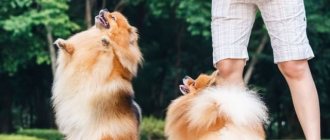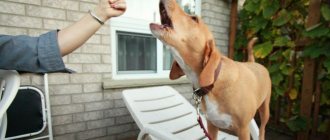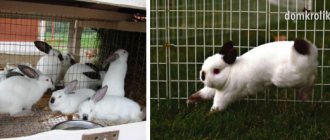Traditional training methods
The success of dog training directly depends on the chosen method. Old school training is based on a system of positive and negative reinforcement, in other words, carrots and sticks.
Training instructions are full of recommendations to use force when the dog does something wrong: “press on the withers,” “pull the leash,” “pull the collar,” etc.
This is how it is advised to teach a puppy the command to Lie down in the traditional way.
Proponents of the old methods do not believe in the dog's ability to understand commands without coercive measures. The main objectives of such training are to suppress the animal’s nature, completely subjugate it, and achieve impeccable automatic execution of commands.
This approach to home training disrupts the contact between the animal and the owner. The dog associates negative emotions with the owner. He perceives him as the center of his troubles, from which he needs to stay away.
Excess negative emotions in sensitive dogs leads to stress. Chronic internal tension is considered the main cause of behavioral problems.
Commands “Fas” (“Take”) and “Give” (“Give”)
The “Get” and “Give” commands are extremely useful when playing with a pet. Let your puppy learn them and remember that they will be followed by play with a ball or toy. This way you will establish clear rules that will always work.
Remember that this type of play is very necessary for a dog, especially hunting breeds such as the Jack Russell. This way you satisfy his hunting needs,
Puppies love to play and their activity sometimes becomes uncontrollable. When your child masters these simple commands, you will be able to guide the process and indicate when he can hunt the toy and when he can let go.
Remember that during the game you are not allowed to grab or bite your hands or various objects (slippers, curtains, rug, etc.),
A good toy that the dog responds to readily can distract him from, for example, a running cat, squirrel or pigeon. It acts on the elements of the hunting chain at the level of reflexes. The puppy watches something run away, chases it, grabs it and drags it along.
Dog training using positive reinforcement
Over the past two decades, trainers and owners have been moving away from traditional home dog training methods.
The positive reinforcement technique relies entirely on the animal’s internal motivation to carry out the owner’s command and denies violent methods.
Dogs are social animals. Nature has endowed them with cognitive abilities aimed at building relationships with humans. In other words, they do not want to conflict with the owner who provides shelter, food, care and love. Dogs are also interested in building peaceful relationships.
The owner can only develop natural abilities and clearly explain what kind of behavior he expects:
- Positive reinforcement is everything that a dog loves and the simplest, most understandable way to convey information: do as I want, and you will get what you love. The animal quickly connects its behavior with a valuable reward. Next time he will complete the task more likely, faster and better.
- Positive reinforcement training takes place against a joyful emotional background and strengthens contact with the owner.
- The dog is sincerely interested in the result. He perceives the first award as an accident, the second as a coincidence, and the third as a pattern. After regular training, she shows initiative in anticipation of a reward, and herself offers the behavior desired by the owner.
- Positive reinforcement training is suitable for animals of any age: from a two-month-old puppy to an adult dog with behavior problems.
When being with the owner is emotionally comfortable, interesting, fun and tasty, basic skills are mastered “by themselves”, without effort.
Positive reinforcement does not mean permissiveness when the owner does not react to the pet’s actions. On the contrary, this is a humane way to set your own rules and teach your dog proper behavior.
Why do you need to train a dog?
The set of commands for non-service dogs can be very diverse. Some owners ask their four-legged friend to bring slippers, others command “Guard!”, and still others teach the pet to bow. Dogs are highly trainable and can learn a wide range of skills.
Of course, the first need for learning commands is education. The dog must understand the prohibition and perform the simplest actions so that the whole family can live comfortably with their four-legged pet.
The second most important reason is discipline. When training, the dog is placed one step lower than the person and understands that she is not a leader. This forms obedient, but at the same time respectful behavior of the animal.
The third reason is that if a dog was bred for specific purposes (watchman, guide, companion, hunter), it must be able to carry out specific commands. They are usually learned under the guidance of an experienced trainer.
Additional, so to speak, bonus benefits include having fun together between the owner and the four-legged dog. Both learn to understand and respect each other, a rapprochement occurs and a strong friendship develops.
Three pillars of home dog training – 3 types of motivation
A dog lives by its own laws, follows its instincts, and does not work for no reason. The driving force behind training is the animal's motivation. If a dog wants to get something, he is ready to strain, think and do.
The most effective 3 types of motivation:
- Food. A healthy dog is always interested in food. This property is due to the survival instinct. The owner encourages him to perform the desired action with a tasty piece and rewards him after correct execution.
- Gaming. Every dog has a hunting instinct. Hence the habit of tugging at objects and catching up. A favorite toy will work just as well as a tasty morsel to guide the animal to the desired action. Playing with the owner will encourage correct behavior.
- Social. This is secondary motivation, which is developed gradually. If you emotionally praise and stroke the dog with a treat or a toy, it will quickly understand the meaning of words and touches. Gradually, praise becomes an independent motivator without the addition of food and play.
It is easiest to control an animal that has developed all 3 types of motivation. A treat, a favorite toy, praise - this is the dog’s salary, for which he is ready to work.
Features of training different breeds
How to properly train a puppy? The basis of training for different breeds of dogs is the same. However, there are still some peculiarities in conducting classes.
- When working with small breed dogs, it is important to use target objects at head level.
- Training of service breed animals is aimed at preparing them to deal with the aggressive actions of offenders.
- When working with hunting breeds, you should focus your efforts on combating their natural instinct.
Why Negative Reinforcement Doesn't Work
Negative reinforcement is any negative impact immediately at the moment of non-compliance with a command. Raising your voice and using forceful methods give temporary results; they have to be constantly tightened.
First, the dog reacts to shouts and obeys. Then he gets used to it and stops noticing. The owner increases negative reinforcement, using jerks on the leash.
This helps temporarily, but the animal adapts to them. You have to pull harder and so on ad infinitum. Particularly “advanced” trainers, out of their own powerlessness, end up with strict or electric shock collars.
Negative reinforcement does not teach anything and does not motivate you to take the right action. During training, the dog feels nothing but fear and disgust towards commands. As a result, he lives in a state of chronic stress.
Sensitive animals develop real neurosis, which is difficult to treat. You can forget about trust, respect and love. Fear becomes the main driver of actions.
Sound markers of positive reinforcement
A beep is a way to instantly indicate the correct execution of a command. To do this, they use a clicker during training.
When you press the button, the clicker makes a clear click of medium volume.
Before the first lessons, train your pet in a calm home environment:
- Click the clicker. Then immediately give him a tasty piece.
- Repeat the exercise 5 – 7 times in a row, take a break.
- During the day, return to it 5–6 more times.
- Practice for 2 – 3 days, then check. Give the signal and watch the animal's reaction. If the dog perks up and looks expectantly, it means he understands the sound correctly and classes can begin.
The clicker is convenient to use, but it has disadvantages. The device takes up your hands, gets lost, and is forgotten. Some dogs find clicking unnerving. In initial lessons, you can use the word “Yes” instead of a clicker. It is said briefly, without emotion, always the same way.
A sound signal is given exactly at the moment of correct execution. He does not cancel the awards. After clicking the clicker or "Yes" marker, the dog is always given a treat, praise, or play. Without encouragement, the signal becomes useless.
Sound markers are convenient for recording short successful moments. You won’t have time to put a tasty piece into your mouth in a moment. The click of the clicker or the word “Yes” tells the animal: you did the right thing, now there will be a reward.
The signal instantly reinforces the execution of a command at a distance when it is impossible to immediately reward the dog. After mastering the skill, sound markers are no longer needed. Clickers and other useful training accessories can be found here.
Stage two: learning unusual commands
Every owner wants to see his dog special, wants to teach him some unusual tricks. The desire to stand out is completely normal, because a well-mannered dog is the pride of the owner and the envy of others.
"Kiss"
To teach this command, contact with the owner must be excellent. This simple trick is based solely on trust between the pet and the owner.
To practice the skill, you need to sit the dog in front of you, say the command “Kiss” and, with a treat clamped in your teeth, lean towards the dog. Correct execution of the order looks like this: the dog places its front paws on its chest and licks its lips. Reinforcing the skill in this case is by encouraging the owner and receiving a treat.
"Serve"
To train, you need to sit your pet in front of you . Hold the treat in your hand in front of your pet’s nose, up and slightly back. The dog will try to reach the food and as soon as it lifts its front paws off the surface, command “Serve” and give the reward.
Another training option could be mechanical stimulation. When the dog is sitting, you need to take it by the front legs with your hands and lift it to the level of the dog's chest, at the same time a command is given. In the correct position, a treat is given, then you can release the dog.
"Spin"
To teach your dog the funny “spin” trick, you need to take a treat in your right hand and, using pointing, force the pet to make a 360-degree turn around itself . Immediately after this, give the reward. Only after several repetitions can you link the dog’s actions to the command, when the animal begins to understand what they want from him.
"Bow"
Executing the command is similar to the order “Lie down” . The dog must stand calmly in front of the owner. After giving the command “Bow,” move the hand with the food down towards the front paws. When a dog stubbornly lowers its croup in an attempt to lie down, you need to support the lower part of the body with your hand.
"Snake"
First, the “Next” command is executed, the dog stands on the left side of the person. The “Snake” command is practiced like this: there should be food in your hand, slowly lead it in front of the dog’s nose, passing your hand between the legs. The movements should be slow so that the dog understands what is required of it.
"Back"
It is not easy to train a dog to carry out this order - in nature, a dog does not walk backwards, it turns its body around.
Starting position – the dog stands in front of the owner. The command “back” is given and the person begins to move towards the dog. Instinctively, the dog will begin to back away a little so that the owner does not step on his paws. Even if the dog took just one step, this is already worthy of praise. The number of steps must be added gradually during training.
"Ring Jump"
The ring must be large enough so that the dog can easily pass through it. First, you need to place the ring on the floor and use a treat to show the direction of movement through the ring. When the dog passes, praise and give a treat. As you practice the skill, gradually raise the ring higher.
At what age should you start training a puppy and how long should you train?
Previously, dog training began at 6 months. During the training, forceful techniques were used that are not acceptable for small puppies.
You can start training with positive reinforcement at home as early as 2 months, and after scheduled vaccinations you can go outside:
- Conduct classes in short sessions, but several times a day, for example, in the morning and evening.
- The total time of one training session for a puppy is no more than 15 minutes, for an adult dog - 40 minutes.
- Repeat one command no more than 3-5 times in a row, then take a break, play with your pet or move on to another task.
- Finish the workout a little before he gets tired or loses interest.
Why do you need to train a puppy?
When a puppy appears in the house, he is first taught how to behave with family members and hygiene. But social behavior and obedience are the main skills that distinguish a well-mannered domestic dog. The puppy learns quickly, remembers commands and, through education and training, the dog owner establishes contact with the dog.
The sooner you start training your dog, with simple commands, the easier life will be side by side. During the training process, when the owner spends a lot of time with the pet, the dog develops a trusting relationship with the owner, provided that training brings pleasure to both.
What commands should a dog know when it grows up?
First of all, training a puppy begins with memorizing its nickname. It’s hard to even call it a team, but remembering the nickname is the beginning of learning. An adult dog living in a city must obey the rules of human society.
Every owner must teach his pet basic obedience commands. Mandatory knowledge of basic commands applies not only to large dogs; even a small terrier is obliged to carry out prohibited orders and the “come to me” command. First of all, this is the safety of your pet in the city.
- The first thing a dog needs to learn after its nickname is “no”, “no” or “fu”. Which word to pronounce is the choice of the owner. The pet does not care what word will mean the immediate cessation of any action; the owner can use absolutely any word for this - for example, “peony”, in any language, with any set of sounds and syllables. Of course, it is better for the prohibition command to be loud - such words are pronounced faster and easier to remember.
- In addition to the ban, it is necessary to teach the dog the “come to me!” command. – this is a very important element on which trust is built. A dog will not approach a person it does not trust. The command “come to me” can sometimes save the life of an animal if the dog suddenly breaks off the leash and runs onto the road.
- The "place" command is also mandatory for training. But it is necessary solely for the convenience of the owner. Every dog has a certain place in the house where it spends the most time and where it feels safe. Going to the place should not be a punishment, because she returns to the place where she will feel calm.
- The necessary commands also include the basic “sit”, “lie down”, “near”. These orders will make life easier for the dog owner, both while walking and at home.
What treat to give a puppy during training?
A tasty piece for training as a pointer. It guides you to the desired action, helps explain the command, and marks successful completion.
The dog is not fed before training, otherwise the pet will not be interested in the treat. A hungry dog is also a bad student. The smell of food will become a strong irritant, distracting attention from the owner.
Feed your pet 2 – 3 hours before training.
Everyday food will not be an effective stimulus. For classes, take the most desirable food that meets the criteria:
- Will not harm the dog's health.
- Doesn't get your hands dirty. For example, raw meat is attractive to animals, but leaves marks on palms and clothes.
- Affordable: food for training is needed constantly, not on holidays.
- Doesn't crumble. The boiled chicken flakes in your hands, falls to the ground, and distracts the dog.
The size of the pieces is made so that the dog can quickly swallow. If he chews the earned treat for a long time, he forgets why he received it. But don’t deceive your pet, don’t give him crumbs that he won’t feel at all.
Here is a treat option that is suitable for training:
- Take beef lung, heart, and liver in equal parts.
- Wash and boil for 30 - 40 minutes.
- Cool, cut into cubes.
Dogs love this food, it is not harmful to health, does not leave marks on the hands and does not fall into pieces.
Other types of training food:
- Boiled stomachs, chicken hearts, cut into cubes.
- Slices of low-fat sausage or cheese are not healthy food, but they will do when you have nothing on hand.
- Ready-made treats for training from a pet store.
Training pads for dogs of any age and breed.
Before starting classes, practice at home how to catch a dog with a piece, teach it to follow your hand.
Bring your fingertips to your nose, let him sniff, and move the side away so that the puppy follows the piece.
Where to start training a puppy
The first condition for successful training is to establish eye contact with your pet.
The basis of house training: eye contact with your pet.
This word hides not just mutual understanding, trust and the joy of communication. This is the ability to look, hold your gaze, concentrate attention on the owner, without being distracted by external stimuli.
The dog thinks about what he sees in front of him. When she looks at her owner, she hears him and is ready to receive and carry out commands.
Therefore, first teach your pet to quickly switch his attention to you:
- At home, sit opposite the puppy, show a piece and hide it behind your back.
- When he starts looking, call him by name.
- Wait until the dog looks into your eyes, catch your gaze at least for a second.
- At this point, give a sound signal with a clicker or the word “Yes,” praise and give the piece.
- Repeat the exercise in a calm environment at home 3 to 5 times in several sessions with breaks.
- Then continue training while walking: first in a vacant lot, then in an area with irritants.
- Gradually increase your concentration time - hold your gaze for 2, 3, 5 seconds. And only then give a sound signal, praise and treat.
Gradually, the puppy will understand that looking at you is beneficial, because they give you a treat for it. He will stop running away during walks and will start looking around more often. This behavior can easily be overridden by other commands.
We teach the command “Fetch, baby”
The “fetch” command is not pampering at all. Thanks to her, the puppy will develop energetic and physically healthy. Having splashed out all the energy on a walk, the baby will be calm and obedient at home.
This command is fully trained from the age of five months. But it is necessary to introduce a four-legged baby to it much earlier. For now, this command will be practiced in a playful manner and will not be strictly observed.
The main condition without which no dog will become active in this process is the owner’s genuine interest in the game. Children cope better with this task.
If the dog does not express a desire to run after the thrown object, you can “revive” it. If it's a stick, kick it with your feet. Surely this will interest the puppy. When he grabs it in his teeth, you can fight with the baby, taking away his prey. As a result, the process will turn into an exciting game. All you have to do is remember to say “fetch” from time to time.
Methods for properly training a puppy in practice are not so difficult. The main thing is that it brings pleasure to both the puppy and its owner. Then there is every chance that the little fool will soon turn into an adult, smart and well-mannered dog and become a source of pride.
What commands can you learn with a dog?
You can independently master basic skills that will greatly simplify your life together with your pet:
- Run up to me instantly when called.
- Sit, Stand, Lye down - take static positions and not move from your place without permission.
- Nearby - do not pull the owner on walks or move without a leash.
- – calmly walk past discarded food on the street, do not pick it up from the ground.
- Place - go to the bed upon request.
- Give - calmly give away a grabbed bone or valuable thing.
- Bring - this skill will come in handy during the game, when you need to release accumulated energy.
To assess progress, mastering a new skill can be divided into 4 main stages:
- First successful execution.
- A dog demonstrates a new skill without hesitation 8 times out of 10 in a quiet, secluded place.
- The command is executed without delay anywhere on the street or at home, with various distractions.
- The new skill becomes part of everyday life, you just have to maintain it.
For major success and transition to the next stage of training, the dog is rewarded with a large portion of the most desired treat. This is like a “jackpot” that is awarded in case of a significant breakthrough.
Tricks for enthusiasts
It’s easy to train a domestic dog to fetch slippers, play thimbles or hide-and-seek, walk another pet on a leash, run next to a bicycle, sit in the “gentleman” position, and dance on its hind legs.
The cup trick is quite easy for an animal to perform. Three identical plastic cups are placed in front of the dog. There is a treat under one, then the cups are moved from place to place in front of the dog’s eyes. Then they offer the pet to get a treat. Each attempt to turn the glass over is accompanied by exclamations of praise. The dog's reward will be the treat he finds. The exercise is repeated several times.
Cup game
The dog does not follow commands - what to do?
Failures in training often occur for three reasons: low motivation, owner mistakes, poor health of the animal:
- Don't rush the dog. She will set the pace herself, because everyone’s learning speed is different. Some people learn a new skill after 5 repetitions; for others, even 100 repetitions are not enough. But even the most brilliant people will not complete a task for the first time in an unfamiliar environment, with strong stimuli.
- Set achievable tasks. Complicate the tasks gradually: the more distracting objects, the more difficult it is for the dog. Train first at home, then outside in secluded corners, then in places with a minimum of irritants. When the puppy begins to succeed, move to areas with strong distractions, where other animals and strangers walk.
If training is moved from the house directly to a noisy yard, the pet will forget all the commands.
- Change your position relative to the dog. Give command while standing opposite, to the side, behind, move 3 to 5 steps to the side. The animal develops a behavioral stereotype; it is difficult for him to complete a task heard from an unusual place the first time.
- Review learned skills periodically. The dog may simply forget them.
- Exercise only in a good mood. If something bothers you or irritates you, postpone your workout. Negative emotions are transmitted to the animal and interfere with learning.
- Set the strongest motivation possible. Experiment with what is more important to your puppy: a toy, a tasty bite, or your approval. In the initial stages, food and play come first. Praise and petting work less well. Sometimes it is enough to change the treat and the result will immediately appear.
- Reward every small success until the new skill is fully mastered. When the animal learns to carry out the command with any distractions, reduce the reward with food, but do not refuse it at all.
- Praise from the heart.
- Monitor your pet's well-being. Sometimes a dog refuses to follow commands if something hurts.
The dog does, without coercion, only what is beneficial to it. Let her understand that correct behavior and following commands are tasty, pleasant and fun. Success will come when your interests coincide with those of your pet.
How to avoid mistakes when training a dog
You cannot start training an animal that is emotionally and physically unprepared for it. Before the next exercise, dogs should have time to rest and recover from intense physical activity.
The training process must be completed when the animal is not yet exhausted and treats the execution of the command not as a duty, but as a game.
Important! You should not rush to get results; haste threatens a nervous breakdown not only for the animal owner, but also for the pet.
You need to start training a new command after the previous one has been completely fixed in the animal’s memory. The command must be given with an imperative intonation and at the moment when the dog hears the owner. You need to praise your pet often and reward it for every correctly executed command.
Any person who takes responsibility for the life of an animal must realize that teaching dogs to obey and carry out vital commands is his duty and not a waste of time, even if the pet is not a huge service dog, but a cute decorative baby.
How to teach a dog the “Come to me” command at home
This is the most important command. It will protect the animal from dangers and the owner from conflicts during a walk. Puppies untrained in the skill of calling are not allowed off the leash on the street.
Completing the task lasts seconds, but the dog will have to be taught three elements:
- Instantly be distracted from your activities and turn your attention to the owner.
- Run up quickly without being distracted by foreign objects.
- After completion, sit at the left leg or opposite, look at the owner, wait for instructions.
In order for your dog to master the exercise 100%, train it first at home, then on the street with various distractions.
How to teach a puppy to call - first steps
First, the puppy is introduced to the “Come to me” command at home:
- The first step is to explain the meaning of the command, form a connection between the words and the movement towards the owner. Call your puppy when he looks, is ready to run, or is heading in your direction.
- Say the command calmly and clearly so that it does not get lost in the flow of words, with positive intonations. When the puppy runs up, confirm success with a sound signal, treat him with a treat, and praise him.
- Second stage - move away 1 - 2 steps. Catch the moment when the puppy looks in your direction, show a toy or food and command “Come to me.”
- The third step is to call the puppy when he is not looking at you, but is not doing anything interesting. When he runs up, take a couple of steps back so that the puppy follows you.
- The fourth step is to give the command when the puppy is captivated by the toy. If he doesn’t react, it means it’s too early to complicate the task. Go back temporarily.
- Fifth step - call the puppy from the next room. Don’t forget to treat and praise every time.
- The final element is to teach him to sit at your feet. Bring the piece to your nose, lift it above the puppy’s head, and move it slightly back to the eye line. When he lifts his muzzle, his hind end involuntarily falls to the floor, that’s how dogs are designed.
The main mistakes in initial training in calling:
- Repeat the command several times. The puppy will get used to running up within 2–5 attempts. The main task for a novice trainer is to learn to recognize when the pet is likely to approach.
- Call in a menacing voice.
- Say your nickname and command together. They should not merge into one word. A name is needed to attract attention, a command is needed to call.
- Calling the puppy for unpleasant hygiene procedures or to scold him for misbehavior.
Associate only positive emotions with your team.
How to teach a dog to look at its owner more often while walking
Outside the house, a new world of sounds, smells, unfamiliar people, dogs and cats opens up for the puppy. Under the influence of impressions, he forgets about the owner and stops noticing.
In such conditions, training is useless. First, make eye contact with your pet on the street, teach him to see and hear you. Find a quiet place with a minimum of irritants or take him out into the yard early in the morning or late in the evening.
To train your puppy's attention, it is useful to perform 3 exercises:
- While walking, stop silently and wait for the dog to look at you. Keep a short leash of no more than a meter. Let the dog run around and sniff around. When he looks at you or approaches you, give a sound signal and reward him.
- After 3 – 5 repetitions, let him run on a long leash. Do 5 of these exercises on every walk.
- Regulate your dog's attention while moving. Walk at a calm pace, then stop. As soon as the dog turns to you, take out a tasty piece and take two steps back. Let him come and take it himself. Soon the dog will turn around during stops.
- Show the treat and turn away. The dog will run in front and begin to look for interaction with you.
At this stage, do not call the dog or pull the leash. The purpose of the exercises is to achieve attention without coercion. If the dog comes up and doesn’t want to leave, play with him. Show how fun and interesting it is to be with you. Then let him run on a long leash.
Become interesting to your pet, and he will not want to walk on his own and run after dogs.
Command “Come to me” on the street
After making eye contact, return to practicing the call. Walking is too much for your puppy to experience, so start the activity close at hand in a quiet place:
- Keep your puppy on a 2-3 meter leash. Show him a toy or treat and call him when he is not interested in anything and looks in your direction. Associate the correct execution of a command with positive emotions. Praise, treat him with tasty snacks, play and let him go for a walk.
- Gradually increase the length of the leash, first to 5, then 7, 10 meters. Call as before when the dog turns to you and is ready to come running. Give commands in a lively, joyful voice.
- Repeat the call every 10 to 15 minutes while walking, give him treats, praise, and send him running again on a long leash. Help the puppy not to be distracted by foreign objects along the way. Run back yourself, encourage them with clapping and praise.
- Then for 5 simple calls add 1 complex one. Give a command when the dog is distracted and not looking at you. Learn to determine how absorbed she is. Call when you are sure of execution. If the dog does not come running when called at the moment of sniffing a beetle in the grass, then he will not be able to switch his attention in the midst of the game.
- Without a leash, a dog behaves differently and often stops obeying. When practicing the “Come to me” command, tie a 10-20 meter long rope instead of a leash. It will give you a feeling of freedom. However, you can step on the tip at any time and control your pet from a distance.
- At the final stage, show what to do after the command is executed. As it approaches, catch your pet with a piece and lead it to the desired place. Then raise the treat above your puppy's head and he will automatically sit at your feet.
When the calling is 100% successful in secluded places, move to areas with external stimuli. Again, start close.
The pet is released from the leash when it immediately runs when called, even if a cat appears nearby or other dogs are playing.
The dog does not come when called - correcting mistakes
According to the rules, the call is given only once, and the dog must come running at the first request. However, the ideal model is not always obtained. Blaming an animal is not productive, try to understand your mistakes.
Here are possible situations that lead to pet disobedience:
- You call the dog in a threatening tone. No sane creature will want to approach if he hears evil intonations. Give commands in a positive voice.
- The pet hesitated, got distracted, and ran up late. You scold for this. The dog lives in the present. She does not connect the owner’s dissatisfaction with the action committed minutes earlier. The pet’s mind combines the disapproval of its beloved owner and the moment of approach. Next time he won't want to run up. Praise and reward even for completing things late.
- The dog doesn't listen, you're trying to catch it. The dog perceives such actions as a game. It’s a pleasure to join in. Try to run away. The dog will instinctively follow. At this moment, turn around, command “Come to me,” and reward after execution.
- On the street you let the dog run freely and play. At the end, you call, buckle up, and take you home. If walks follow this scenario, the joy and fun ends for the dog after following the order “Come to me.” Call your pet 5-10 times per walk. Praise him and send him running again. To smooth out the moment of returning home, play a little along the way.
Sometimes owners behave unpredictably. During training, commands are consistently taught using positive reinforcement. At home they scream and beat you for wrongdoing. As a result, the dog is afraid to approach. He simply doesn't know what to expect from the owner.
If you have difficulty training your dog on his own, you can sign up for training courses. Each dog handler has his own experience and valuable findings. Even on free webinars you can find a lot of useful information for yourself.
Instructions for training first skills
When a puppy appears in the house, its upbringing begins immediately. Of course, you cannot constantly give an inhibitory command, unless, of course, the owner wants to get a neurotic dog in the future. But some rules of behavior (not to confuse raising a puppy with training a puppy at home) must be instilled in the animal from the very first days, regardless of the breed of the baby, be it a charming dachshund or a handsome Great Dane.
How to train a husky: raising a puppy at home
As many future owners know, you cannot walk your pet until the second vaccination. The first is often done by the breeder, the second by the owner. But the baby goes to the toilet, will the whole apartment really turn into a springboard for dog waste? Nothing of the kind, the owner just needs to teach the pet to do its business in the diaper.
Note! Disposable diapers for animals are sold in all pet stores; they are quite cheap and economical to use.
So, barely noticing how the puppy is restlessly marking time, trying to choose a secluded corner for his needs, the owner carefully picks him up, carries him to a diaper, sits him down, strokes him and says “here”, “business”, etc. After that As a husky, mistakenly called a husky by the people, a pug or a chow-chow, as well as a puppy of any other breed, has done its business, it is praised and treated to something tasty. Within normal limits, of course, the treat should be one sip.
The owner must act in this way until the puppy learns to run on its own in the diaper, having felt certain calls from the body.
Now it remains to consider the problem of the pet walking throughout the apartment. Some people allow the baby to move around the house, while others don’t want this at all. Therefore, from the first days of a puppy in the house, he is taught to move only in a certain area, for example, in the hallway and in the kitchen.
If the owner entered the room, and his corgi, Doberman or Akita Inu ran in after him, the actions are as follows:
- They take the baby in their arms.
- They are taken out of the room.
- Place it at the entrance so that the pet can see the owner.
- They say the command “wait”.
- They enter the room for a few seconds.
- They go out to the puppy, praise him and encourage him.
A pet trained in this way will wait for the owner not only in the house, but also at the door of a store, for example. Although it is not recommended to leave the animal outside without the supervision of the owner unless absolutely necessary. You can go shopping without a dog, you never know how many inappropriate people there are around. Representatives of small breeds are especially often stolen, but large dogs are also taken away from store doors.
Ideally, the pet should also have its own house where it can relax without outside interference. Today, special dog cages and boxes are popular; they can be seen in the photo below.
Boxing for dogs
The dog feels comfortable and cozy in such a “pen,” although a lot depends on the breed of the pet. It is unlikely that Yorkies, being rather shy dogs, will be happy in a confined space. But larger and more balanced representatives of a particular breed, for example, Labradors, will simply be happy to be alone with themselves.
Stages of accustoming a puppy to a bed (box, crate, kennel):
- First you need to put a treat in the box so that your pet can see it.
- Then the word “box” or “place” is pronounced and the puppy is shown the direction with his hand.
- When the dog enters the kennel (box, cage), the door closes. When he eats the treat, praise your pet and after 3-5 seconds. release into the wild.
- The time the dog stays in the box increases by 1-2 seconds every day. When the puppy learns to be calm in a confined space, you can slowly begin to leave your pet alone.
And finally, training to use a collar and leash. This should be done from the first days of the baby’s stay in the house. The owner simply puts the collar on him for a few seconds at first, gradually increasing the time. If the animal reacts calmly to a foreign object on its neck, it is praised and treated to something tasty.
Note! The main thing is to take into account the breed of the puppy. Some immediately get used to the collar, being strong and with a stable psyche (Laika, as an option), while others try to faint as soon as they feel it on their neck. The owner must act delicately, wisely, without morally violating the pet.
Walking on a leash
Team Near – Homework
This is a difficult task. The dog needs to be able to start moving, accelerate, slow down, stop, and make turns. First, determine the pet’s place next to you - at your left, right leg, or is it allowed to walk on either side. Determine for yourself how far it can move. Usually the leash sags a little.
The more clearly you present the model of your pet’s future behavior, the more clearly you explain, and the puppy will understand faster.
Conduct the first lessons at home, dedicate to explaining the command. At the same time, introduce the puppy to the leash:
- Put the leash on so that it has a little slack. Stand near your pet and give him a tasty bite. This way you will designate a place near you. Do not enter a verbal command yet. It is perceived as noise and prevents the puppy from concentrating on the task.
- Take 1 - 2 steps forward. When the puppy follows you, praise and treat.
- Gradually increase “walks” around the house, constantly reinforce correct behavior with praise and treats.
- When the puppy begins to move freely at your foot, introduce the word Near. This is the only command that can be repeated more than once.
When the dog understands the meaning of the command, move on to walking exercises.











